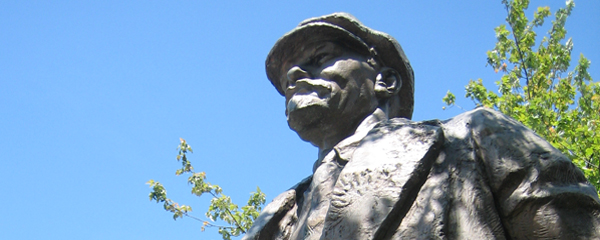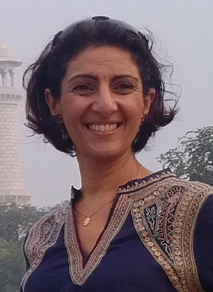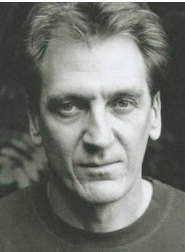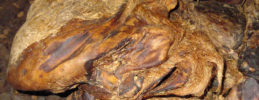
('Lenin Statue'© keystricken, 2006)
In this essay, one of two runners-up in the 2018 THRESHOLDS International Short Fiction Feature Writing Competition, FARAH AHAMED examines the shifting nature of political and historical events in satirical short stories by R.K. Narayan and Ivan Vladislavic.
~
Comments from the judging panel:
‘A very engaging piece – alert to the interesting ironies and unchanging truths of our cultural biases and blind spots.’
‘I enjoyed the yoking together of these two political satires, and the writer skilfully darts from one to the other.’
‘This is a rich and deep piece which connects history and commemorative statues to the shifting nature of political and historical events. So a very ambitious and worthwhile piece..’
~
 Farah Ahamed’s stories have been published in various anthologies and journals including The Massachusetts Review, The Missing Slate, Enkare Review, Kwani? and Out of Print. She was highly commended in the 2016 London Short Story Prize, joint winner of the inaugural Gerald Kraak Award and has been nominated for The Caine and The Pushcart prizes. She was shortlisted for the Screen Craft Prize, SI Leeds Literary Prize, DNA/Out of Print Award, Sunderland Waterstones Award and The Asian Writer Short Story Prize.
Farah Ahamed’s stories have been published in various anthologies and journals including The Massachusetts Review, The Missing Slate, Enkare Review, Kwani? and Out of Print. She was highly commended in the 2016 London Short Story Prize, joint winner of the inaugural Gerald Kraak Award and has been nominated for The Caine and The Pushcart prizes. She was shortlisted for the Screen Craft Prize, SI Leeds Literary Prize, DNA/Out of Print Award, Sunderland Waterstones Award and The Asian Writer Short Story Prize.
~
THE TYRANNY OF HISTORY
By FARAH AHAMED
If, one wintry afternoon, you were to find yourself walking in Bloomsbury, and you decided to take a stroll in Tavistock Square, you might see a woman in a black winter coat and red hat standing in front of the monument in the middle of the square. Nothing unusual about that, you might say, except that, if you were to stare long enough you might see her dusting the snow from the statue, removing dead flowers from its neck and replacing them with a fresh garland. If you were to go closer and observe more carefully, you would see her wiping away the cobwebs from the statue’s ears and nostrils, and lighting candles in the hollow base of the pedestal. If you were curious enough to walk around the monument, you would find yourself looking at the sculpture of an emaciated, half-naked old man, seated in a posture of contemplation. Peer at the inscription, and you would discover it is none other than: Mahatma Gandhi.
If by chance you pass through the square on International Women’s Day and see the purple-and-green banner, More Statues of Women, on the railings near the statue of Virginia Woolf, you might ask yourself: after fifty years in the square, should Gandhi be replaced by the statue of a woman who changed history? And if so, what would happen to the monument of him?
The significance, symbolism and legacy of monuments are the premise for two short political satires: ‘Lawley Road’ by Indian writer, R.K. Narayan, written in 1943, and ‘Propaganda by Monuments’ by South African writer, Ivan Vladislavic, published in 1996. Coincidentally, Gandhi lived in both India and South Africa.
 In these stories about administrative absurdities the writers examine how history is acknowledged and resisted: Narayan’s story is about the legacy of colonialism, while Vladislavic looks at the burden of communism and apartheid. In both stories, the characters resist the constraints of their pasts and attempt to negotiate the paradoxical changes of the present. On one level, the narratives are about the ambitions of the individual, and on another, they illustrate how characters are embedded in, and influenced by, their particular political histories and landscapes.
In these stories about administrative absurdities the writers examine how history is acknowledged and resisted: Narayan’s story is about the legacy of colonialism, while Vladislavic looks at the burden of communism and apartheid. In both stories, the characters resist the constraints of their pasts and attempt to negotiate the paradoxical changes of the present. On one level, the narratives are about the ambitions of the individual, and on another, they illustrate how characters are embedded in, and influenced by, their particular political histories and landscapes.
‘Lawley Road’, told from the first-person point of view, uses unpretentious, simple language and a conversational style. It shows with descriptive realism and humour, the challenges faced by the Municipal Council of Malgudi, an imaginary Indian town. None of the characters are named, and the narrator is simply referred to as the Talkative Man.
Narayan believed ‘society presses upon us all the time’, and no more than in Malgudi, where the Chairman of the Council is thinking about how to erase the memory of colonialism. It is the week after the Independence Day celebrations and he feels he has not done enough. He would like to leave a legacy. He proposes the names of streets, parks and localities be changed, and of course, because patriotic names like Mahatma Gandhi Road, Nehru Road and Netaji Subhash Bose Road are the most popular, the Council ends up giving more than one street the same name, causing great confusion.
The real problem starts when the Chairman decides that the colonial statue of Sir Frederick Lawley, ‘with breeches, wig and white waistcoat and that hard determined look’, which is in the Lawley Extension, now Gandhi Nagar, ought to be removed. He announces his decision and ‘people dropped their normal occupations and loitered around the statue wondering how they could have tolerated it for so many years.’ The statue is twenty feet high and fixed on a lead pedestal.
Written fifty years after Narayan’s story, Vladislvic’s ‘Propaganda by Monuments’, is a parody of Lenin’s ‘monumental propaganda’, which used monumental art, slogans and sculpture to transmit communist ideas. In contrast to R.K. Narayan’s linear storytelling, Vladislavic’s story is divided into five chapters. In an interview with 3a.m. Magazine Narayan said: ‘The internal organisation of the text, its structure, the proportion of its parts, questions of symmetry and so on are important… Intuition plays a large part — something you develop through practice.’
Apart from a chapter detailing Lenin’s motivations in the monument project, stating that they should be ‘intelligible to the masses’, and appropriately unveiled, the four other chapters alternate between the main characters, Pavel Grekov, a Russian English–specialist, and Boniface Khumalo, a tavern owner in Pretoria.
When Khumalo reads in the Pretoria News that the Moscow City Council had taken down sixty-two of the sixty-eight statues of Lenin and was giving the ‘surplus’ away, he has a brainwave. Apartheid has ended and his establishment ‘needed more than a change of name to face the future in; it needed a change of clothes.’ He responds to the advertisement, asking if he could be gifted, or purchase on ‘favourable terms’, a ‘spare statue’ for his ‘V.I. Lenin Bar and Grill’. The letter is passed to Grekov, a ‘bored’ translator in the Administration of Everyday Services who translates this ‘important’ document using his own method of personal speculations ‘that exceeded the bounds of his responsibilities’, including ‘guesses at meanings, useful turns of phrase culled from memory and the dictionary, corrections of spelling mistakes.’ Grekov hopes the assignment will lead to a promotion in the Ministry of Foreign Affairs.
In ‘Lawley Road’, tenders for the removal of Lawley’s statue are invited, but the Council cannot even afford the lowest quote and eventually offer it free of charge to the Talkative Man, provided he remove it at his own cost. The Talkative Man hopes to melt the statue and make a profit from the metal. He hires a dozen men to bring it down and bullocks to cart it away. But despite being hacked at for ten days, the statue won’t budge. Finally, it is blasted off its foundation and, with great difficulty, is transported to the Talkative Man’s house. Here it lies, ‘head and shoulders in the front hall and the rest stretched out into the street through the doorway’, and despite the obstruction on the street, none of the residents of Kabir Lane mind. However, it is soon discovered there has been a case of mistaken identity regarding Sir Frederick Lawley.
There was a Sir Lawley, during the time of Lord Warren Hastings, who had been a cruel and ruthless tyrant. But this Lawley, whose statue has just been removed, had been a kind man and a friend of the people of Malgudi.
The government orders the Chairman to reinstate the statue. The public is furious and pickets outside the house of the Talkative Man, shouting slogans and demanding the statue be restored it to its original place. But the Talkative Man says he will not part with it unless the Council reimburses his removal costs, and defiantly advertises the metal from the statue for sale, ‘as an ideal gift for a patriotic friend.’ The Council issues him with a notice under ‘The Ancient Monuments Act’, and a legal battle begins.
While R.K. Narayan illustrates how the fortunes of a monument could change because of incompetence, Vladislavic contemplates what happens when statues are discarded by deliberate government policy. In ‘Propaganda’, Grekov sets out to look for the unwanted statues. He finds himself at the place where the largest head of Lenin in Moscow is being removed. He studies the statue and finds its eyes are
…kindly, if not quite grandfatherly…but as the mouth came into focus, beneath the sculpted wings of the moustache, the whole face changed; it became severe and irritable; it took on the expression of a bachelor uncle who didn’t like children. And then…as he came closer…the face foreshortened into friendliness again.
One of the workers tells Grekov the statues are being deposited in the ‘scrap heap… of history’. The material they were made from would determine their end, except those made by famous artists which were to be ‘preserved’ and stored, ‘behind the bus terminus.’ After the statue is removed, Grekov looks for an inscription, but finds none. He reflects on ‘how soon people become bored with the making and unmaking of history’, and tries but fails to imagine what will take Lenin’s place.
 Grekov responds to Khumalo’s letter, which he has carbon copied and handles with gloves, and gives him the proportions of the monument: seven metres high and seventeen metres in circumference. He writes that it will ‘necessitate Herculean efforts in the transportation, but [will be] well worth it’, and adds a humorous post script- ‘…do you question why monuments, large and small, have no hats? The head of Lenin in history was fond of hats, precisely caps.’ Grekov is confident the endeavour will end positively.
Grekov responds to Khumalo’s letter, which he has carbon copied and handles with gloves, and gives him the proportions of the monument: seven metres high and seventeen metres in circumference. He writes that it will ‘necessitate Herculean efforts in the transportation, but [will be] well worth it’, and adds a humorous post script- ‘…do you question why monuments, large and small, have no hats? The head of Lenin in history was fond of hats, precisely caps.’ Grekov is confident the endeavour will end positively.
In ‘Lawley Road’, six months after the legal battle began, Lawley’s statue has still not been reinstated. The Chairman receives a query from the government. Afraid now that, if the Council were dissolved and fresh elections held, he could lose. The Chairman is persuaded by the Talkative Man to use his own funds to buy the statue, and also the Talkative Man’s house. He converts it into a National Trust Property and renames Kabir Lane, Lawley Road. The reader wonders, will the people of Malgudi refer to it as new Lawley Road or old Kabir Lane? Narayan takes the reader in a full circle of bizarre twists.
In ‘Propaganda’, the question of reconstruction of the environment and identity in the post-apartheid era is more central. When Khumalo receives Grekov’s letter detailing the scale of the project, he tells himself that ‘The Total Onslaught’ of apartheid is over. He drives through Van Riebeecksvlei to Pretoria and recognises the neighbourhood is white even though ‘there wasn’t a white face in sight’. He stops at a building site, sees an old man taking away unbroken tiles and bricks in a wheelbarrow, and reflects on the deterioration around him.
In an interview with The New Yorker, Vladislavic discusses the idea of an environment being continually in a state of flux, and describes Johannesburg as ‘rising and falling simultaneously everywhere’. He meant it not metaphorically, but was referring to how heritage buildings sometimes disappear over the weekend, when few people are likely to notice. He reflects on how this affects people’s sense of identity and belonging.
Khumalo examines the monument of J.G. Strijdom, an Afrikaaner nationalist and strong proponent of apartheid. He is pleased to find it has a look of ‘stupefied terror’, and from the inscription learns the monument was unveiled by Strijdom’s wife. He realises with a shock that his Lenin statue is at least three times bigger and will be impossible to accommodate in the tavern. In a comic moment, Khumalo decides to donate it to the community as a tourist attraction, install it on the empty plot of land near the police station, put his own name on the plaque and unveil it himself. He sees the sun shining through the statue’s ‘finely veined bronze ears’ and begins to understand ‘how, but not necessarily why, the impossible came to pass.’
Every society feels it has evolved a greater understanding of a truth and seeks to entrench this belief, forgetting that in time new realisations will lead to a new dismantling, discarding and repositioning to find a hard-won balance that will also prove temporary. ‘Lawley Road’ and ‘Propaganda by Monuments’ can be read, at least in part, as a way of understanding history as an attempt to order and re-order things that cannot be controlled, and comprehending a society which for Vladislavic was ‘trying to control and letting things go, between order and chaos’. For R.K. Narayan, it was forcing its demands on confused citizens.
Fifty years from now, if you take a stroll in Tavistock Square, what will you find? Will there be only statues of women or more statues of men? That there will be monuments, as Grekov says, ‘is the one certainty we have.’ That we will want to alter them is another.

